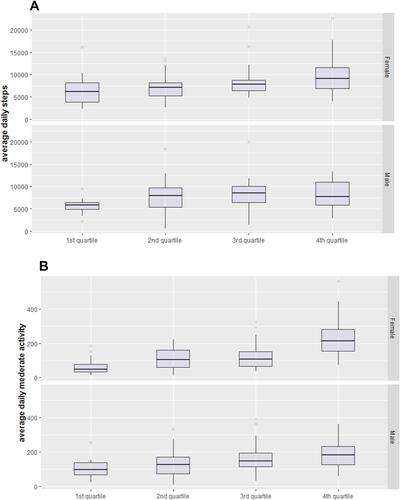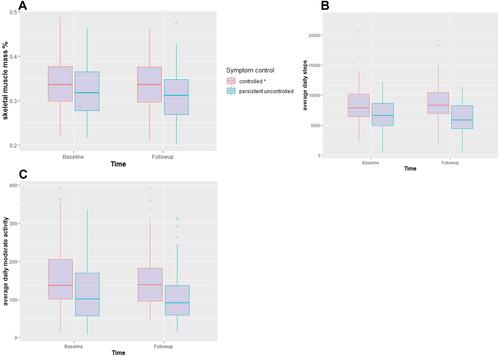Figures & data
Table 1 Baseline Clinical Characteristics of Patients with Asthma and Healthy Controls
Table 2 Clinical Characteristics of Asthma Patients Based on Skeletal Muscle Mass and Gender
Figure 1 Physical activity in asthma patients in relation to skeletal muscle mass quartiles and gender: (A) the distribution of average daily steps in muscle mass quartiles. (B) the distribution of at least daily time in moderate activity according to muscle mass quartiles. In females, the post hoc analysis showed statistically significant differences in means of average daily steps between the first and fourth quartiles (p<0.0001), first and third quartiles (p=0.005), and second and fourth quartiles (p=0.01), (A, upper panel). The average daily time of at least moderate activity was significantly different between all quartile (p<0.001) except between the second and third quartiles (p=0.08) (B, upper panel). In males, average daily steps were only significantly different between the first and fourth quartiles (p=0.031), and between the second and fourth quartiles (p=0.002) (A, lower panel). Likewise, the average daily time of at least moderate activity was also significantly different between the first and fourth (p=0.031), and between the second and fourth quartiles (p=0.026) (B, lower panel).

Table 3 Predictors of Body Composition in Asthma
Table 4 Measures of Body Composition, Physical Activity and Symptom Control at Baseline and Follow-Up
Figure 2 Longitudinal differences in muscle mass (A) average daily steps (B) and time of at least moderate activity (C) between persistent uncontrolled and controlled asthma patients at baseline and follow-up. Patients with persistent uncontrolled asthma had lower muscle mass (A), lower average daily steps (B) and time in at least moderate activity (C) at baseline and at follow-up p<0.01 compared to the rest of patients.

